20774_Problem_solving_Year_6_Number_and_place_value_Patterns_and_algebra_1
Create successful ePaper yourself
Turn your PDF publications into a flip-book with our unique Google optimized e-Paper software.
TEACHER NOTES<br />
<strong>Problem</strong>-<strong>solving</strong><br />
To read, interpret <strong>and</strong> analyse information<br />
Materials<br />
calculator<br />
Focus<br />
These pages explore concepts of <strong>place</strong> <strong>value</strong>, number<br />
sense <strong>and</strong> using data. The relationships among numbers<br />
<strong>and</strong> <strong>place</strong> <strong>value</strong> is analysed <strong>and</strong> students are encouraged<br />
to not only find possibilities but to also disregard numbers<br />
<strong>and</strong> combinations that are not possible. Data needs to be<br />
interpreted <strong>and</strong> analysed to find solutions. See the note on<br />
using a calculator (page xx) for ways to use the different<br />
functions.<br />
Discussion<br />
Page 9<br />
This investigation requires students to read <strong>and</strong> interpret<br />
information <strong>and</strong> use this information to find a solution.<br />
Students need to think in terms of fixed costs occurring<br />
regardless of income <strong>and</strong> variable costs occurring<br />
according to production. The variable cost per item is<br />
not given as such <strong>and</strong> students need to use information<br />
regarding 500 items which have a variable cost of $7500<br />
to identity that the variable cost per item is $15.<br />
Once the table is complete the data can then be used to<br />
work out at which point the factory moves from making a<br />
loss to making a profit. The point at which this occurs is<br />
not shown in the table <strong>and</strong> students need to take what<br />
they know—that she is making a loss at 100 items but<br />
making a profit at 250 <strong>and</strong> somewhere in between is<br />
where the break-even point will occur.<br />
Page 10<br />
These problems are easy to state <strong>and</strong> investigate using<br />
a calculator’s memory function to simplify the steps <strong>and</strong><br />
assist in developing <strong>algebra</strong>ic thinking as the patterns<br />
described in words for the examples used are translated<br />
into early proofs in general. The first problem investigates<br />
a pattern based on the difference of two squares that<br />
was first used in Book E, but now the focus is on why<br />
the result would be true in general. The second problem<br />
is an investigation based on the difference of two cubes.<br />
The pattern can be discerned as the examples are worked<br />
through using the calculator, but showing why this is<br />
true in general requires quite sophisticated <strong>algebra</strong>ic<br />
reasoning which should be underst<strong>and</strong>able by the children<br />
but not necessarily a form of thinking they would come to<br />
by themselves.<br />
Page 11<br />
The puzzle scrolls contain a number of different problems,<br />
all involving strategic thinking to find possible solutions. In<br />
most cases students will find tables, lists <strong>and</strong> diagrams are<br />
needed to manage the data while exploring the different<br />
possibilities. In some cases the information needs to<br />
be analysed to find a pattern to find out solutions. For<br />
example, in the investigation involving ‘3 digit numbers<br />
adding to 6’ the possible solutions from numbers in the one<br />
hundreds can then be used to determine other numbers in<br />
the 2 hundreds <strong>and</strong> so on.<br />
The scroll exploring 3-digit numbers when dividing by 5<br />
<strong>and</strong> 7 would mean that each number had to end in a 3 or<br />
an 8. The first 3-digit number divisible by 7 is 105. If we<br />
add 2 to this number we get 107 which can be our starting<br />
number for looking for other numbers. If we key 107 into<br />
a calculator, add 7 <strong>and</strong> press equal it will keep adding 7<br />
each time. If we then record any numbers which end in a<br />
3 or an 8 <strong>and</strong> we have the numbers which will result in a<br />
remainder of 3 when dividing by 5 <strong>and</strong> a remainder of 2<br />
when dividing by 7.<br />
For the scroll exploring the number of beads students can<br />
again think in terms of multiples. If they find 13 by 8 (the<br />
first 3-digit multiple of 8) which is 104, add one to this<br />
number to give the starting number. Again a calculator can<br />
be used (add 8, press the equal key <strong>and</strong> it will add 8 each<br />
time). These numbers can be recorded <strong>and</strong> students can<br />
then look at multiples of 7 (with 1 added) <strong>and</strong> highlight<br />
any numbers that are the same <strong>and</strong> then, from these<br />
possibilities, check to see if it is also true for 6.<br />
Possible difficulties<br />
• Difficulty with the concepts of fixed cost <strong>and</strong> variable<br />
costs<br />
• Difficulty with the concept of profit <strong>and</strong> loss<br />
• Poor underst<strong>and</strong>ing of <strong>place</strong> <strong>value</strong><br />
• Wanting to add, subtract or multiply rather than using<br />
<strong>place</strong> <strong>value</strong> or number sense<br />
• Not using all the criteria<br />
Extension<br />
• Students could think up their own profit <strong>and</strong> loss<br />
problems using different criteria.<br />
• Students could make puzzle scroll cards where they<br />
take the existing card <strong>and</strong> change the numbers or<br />
context to make a new problem.<br />
8<br />
<strong>Problem</strong>-<strong>solving</strong> in mathematics www.ricpublications.com.au R.I.C. Publications ®

















